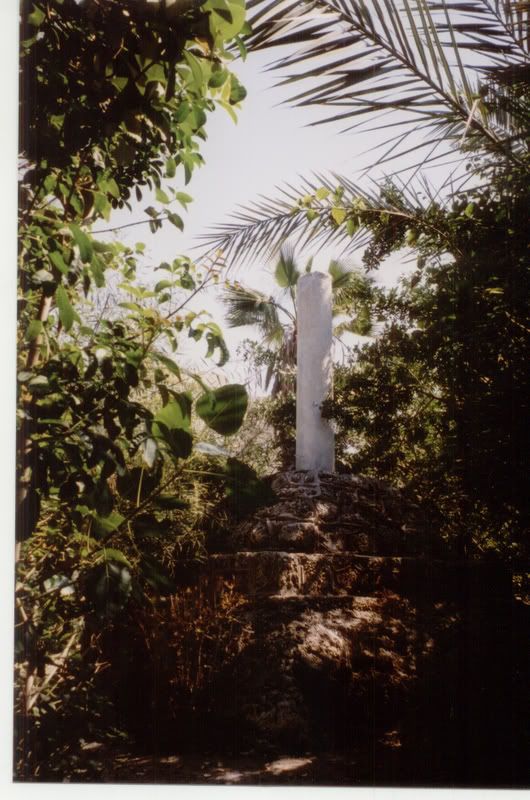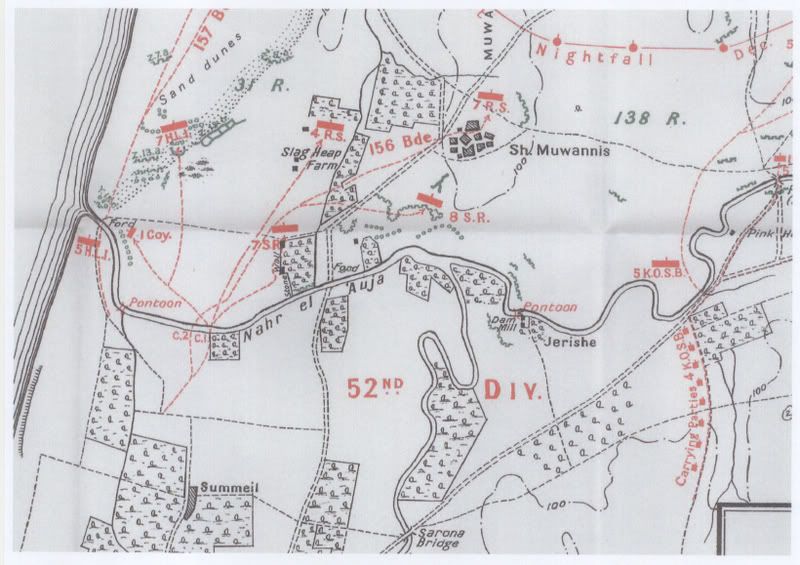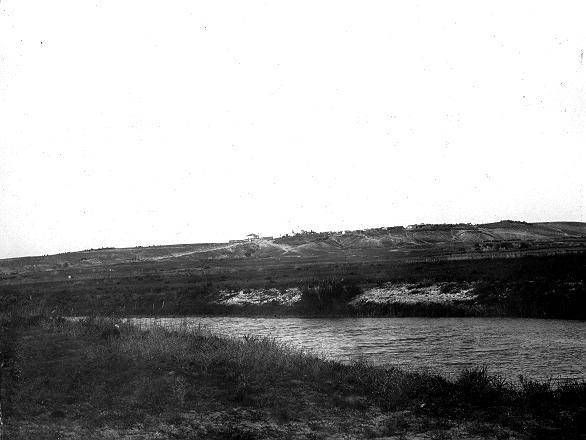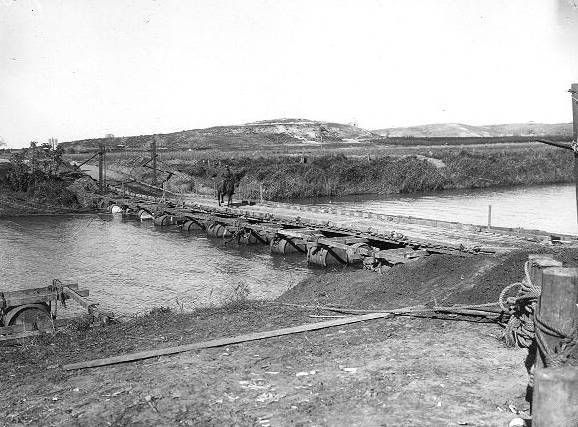michaeldr
Joined: 25 Dec 2006
Posts: 32
|
 Posted: Thu Apr 26, 2007 12:03 pm Post subject: 156th Brigade - Crossing the Auja Posted: Thu Apr 26, 2007 12:03 pm Post subject: 156th Brigade - Crossing the Auja |
 |
|
156th Brigade - (1/4th & 1/7th Btlns Royal Scots and 1/7th & 1/8th Btlns Scottish Rifles)
Crossing the Auja, 20th-21st December 1917
When I put up the thread about the 155th Brigade [see http://warmemscot.s4.bizhat.com/warmemscot-post-2753.html#2753] I was unaware that in fact, all three of the pillars erected by General Hill and his 52nd (Lowland) Division to mark their 1917 crossing of the Auja, had survived. On a recent Saturday walk around this battle ground however, I was lucky enough to run into some volunteer guides from the Avshalom Institute who kindly pointed out to me where the other two pillars are sited.
One further column which I can describe here is that of the 156th Brigade, but the other, to the 157th Brigade, will have to wait a while as there is currently some redevelopment work going on where it is and I cannot get to it to take a photograph.
156th Brigade: Their column stands at the top of a Tel Aviv street named after the prophet Joshua Bin-Nun, in a small residential square which has been called after General Hill himself. The column stands on the top of a tel which has seen human occupation for several thousands of years and cut into the rock underneath the column is a tomb which is thought to date from Old Testament times, 2,500-3,000 years ago. Today the rock out-crop and column form the high point of a small public park with trees, bushes and an artificial, though attractive looking waterfall.
The inscription on the column reads as follows;
'On the night
20th-21st Dec. 1917
the 156th Brigade
52nd (Lowland) Div.
crossed at this
point by light
bridges and rafts
and captured
the Turkish
positions at Sh. Muannis'

The account of this action written by W. T. Massey, which is reproduced on the 155th Brigade thread, is well worth the read. As is General Allenby's report on operations dated September 18, 1918, which covers the period in question. Here Allenby describes how he must 'provide more effectively for the security of Jerusalem and Jaffa' and that this entails his line being advanced.
"The chief obstacle lay in the crossing of the Nahr el Auja. This river is only fordable places, and all approaches to it are overlooked from Sheikh Muannis and Khubet Hadrah. At these places two spurs running from north to south terminate abruptly in steep slopes some 500 yards from the river.
Before the XXIst Corps could reach its final objectives, it was necessary that guns should move forward with the infantry. Consequently Sheikh Muannis, Khubet Hadra, and the high ground overlooking the river had to be captured as a preliminary to the general advance in order that bridges might be built.
The chief difficulty lay in concealing the collection and preparation of rafts and bridging material. All preparations were completed, however, without attracting the enemy's attention, and on the night of Dec. 20-21 the 52nd Division crossed the river in three columns. The enemy was taken completely by surprise. The left column, fording the river near its mouth, at this point four feet deep, captured Tell el Rekkeit, 4,000 yards north of the river's mouth; the centre and right columns, crossing on rafts, rushed Sheik Muannis and Khurbet Hadrah at the point of the bayonet. By dawn a line from Khurbet Hadrah to Tel el Rekkeit had been consolidated, and the enemy deprived of all observation from the north over the valley of the Nahr el Auja.
The successful crossing of the Nahr el Auja reflects great credit on the 52nd (Lowland) Division. It involved considerable preparation, the details of which were thought out with care and precision. The sodden state of the ground, and, on the night of the crossing, the swollen state of the river, added to the difficulties, yet by dawn the whole of the infantry had crossed. The fact that the enemy were taken by surprise, and that all resistance was overcome with the bayonet without a shot being fired, bears testimony to the discipline of this division. Eleven officers, including two battalion commanders, and 305 other ranks, and ten machine guns were captured in this operation.
Dec. 21 was spent in building bridges. Considerable hostile shell fire was experienced during the day, chiefly from the right flank. From Mulebbis the enemy could observe the valley of the Auja. Despite this the bridges were completed, and by dusk the whole of the Divisional Artillery of the 52nd Division had crossed to the right bank, ready to support the advance to the final objectives.
On the morning of Dec. 22, the 54th Division on the right drove the enemy from the orchards which surround Mulebbis, and captured the villages of Rantieh and Fejja. On the left the 52nd Division reached all their objectives and consolidated the line Tel el Mukhamar-Arsuf, the latter place, although two miles beyond the allotted objective, being occupied to deny direct observation on Jaffa harbour to the enemy.
During the day, the Royal Flying Corps attacked the enemy with bombs and machine-gun fire as he withdrew, inflicting numerous casualties.
Throughout these operations the XXIst Corps received most effective support from the Royal Navy.
This operation, by increasing the distance between the enemy and Jaffa from three to eight miles, rendered Jaffa and its harbour secure, and gained elbow room for the troops covering Ludd and Ramleh and the main Jaffa-Jerusalem road."
The map below is taken from the British O.H.

Some further details are given in the following account which appears in 'The Advance of the Egyptian Expeditionary Force - July 1917 to October 1918; compiled from Official Sources.' This has recently been republished by the N & M Press and is from the Second Edition (HMSO) 1919.
"Three days' heavy rain followed which considerably increased the volume of water in the Auja and did much to render its south bank difficult of access by turning the plain into a mud swamp. In spite of this the surprise attack was successful. The covering parties crossed unperceived during the night of Dec. 20 amid wind and rain in their corracles, and the bridges were placed in position. Owing to the extreme lightness of their construction (they were designed to be carried nearly two miles), some of them collapsed after a time, and the 156th Brigade had to link arms and cross breast deep at the ford. The enemy's trenches covering the river were rushed in silence and captured. Sheikh Muannis was carried at the point of the bayonet, Kh. Hadrah was rushed and captured, and by dawn of Dec. 21 the 52nd Division had occupied the whole line from Hadrah to Tel el Rekkeit on the sea two miles north of the river mouth. The enemy had been completely taken by surprise and lost many killed in addition to 316 prisoners and ten machine guns...................................................
As a result of this successful advance the Turks were driven back five miles and Jaffa became more secure as a landing place for stores."
Tel Aviv was founded in 1909 as a small collection of houses beyond the northern outskirts of Jaffa. Seven years later, in 1916 it had a population of only 1,248, however by 1995 it had grown to a city of c.355,900. Thus it will be understood that because of housing development since 1917, one can no longer see the river from the 156th Brigade's monument. However the IWM have a couple of photographs looking across the Auja at this point and towards Muannus and one of these photographs also shows the barrel bridge "which had been put together in a wadi flowing into the Auja, was floated down and placed in position. There was a good deal of shelling by the Turks, but they fired at our new positions and interfered but little with the bridge construction." (Massey)

 |
|






